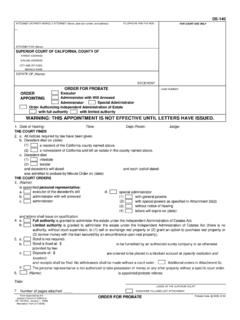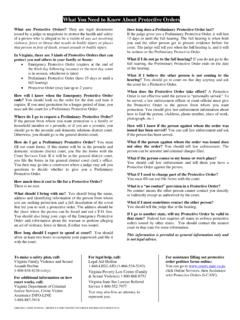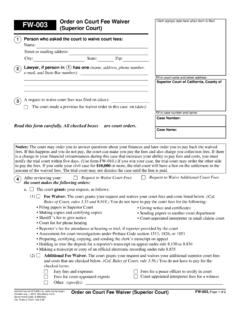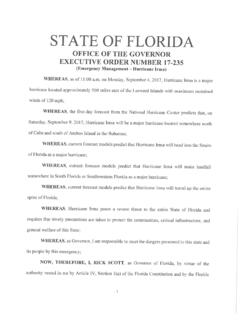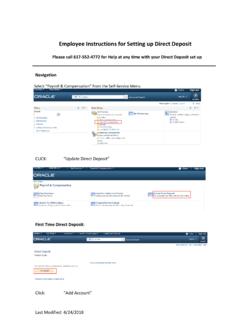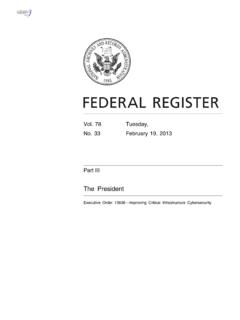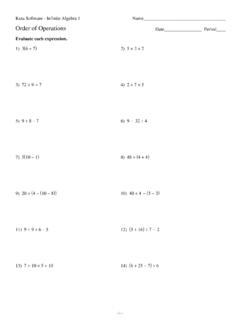Transcription of 090-2011: ORDER, ORDER PLEASE: SORTING DATA …
1 Paper 090-2011 ORDER , ORDER please : SORTING data USING PROC REPORT Lisa Fine, United Biosource Corporation, Ann Arbor, MI ABSTRACT PROC REPORT is one of the more useful SAS tools for generating formatted reports. One of the key expectations for customers of our reports is providing output in a sorted ORDER . Accomplishing that sorted ORDER is not always obvious or easy. This paper clarifies and demonstrates various SORTING options and techniques for achieving a desired sort ORDER when using the REPORT procedure. The paper presents the difference between ORDER and ORDER = options and details how the two options should be used together. The available types of sorts, how to sort multiple columns when display ORDER differs from sort ORDER , and techniques for creating a sort variable, one which incorporates the use of an alias are also discussed. INTRODUCTION The purpose of this paper is to demonstrate various SORTING options, and requirements, when using PROC REPORT.
2 Specifically, the use of the ORDER options is discussed here. (Other SORTING methods such as using the GROUP option are beyond the scope of this paper). There are two ORDER options in PROC REPORT that direct how PROC REPORT output is sorted. These are the ORDER usage, and the ORDER = options. It is important to understand the function of each option, and how the ORDER and ORDER = options work together, to ensure expected results. SORTING data WITH PROC REPORT HERE IS AN OVERVIEW: The desired ORDER of rows can be specified within the DEFINE statement. Here is an example of very basic syntax: proc report data =vitals; column visit; define visit / ORDER ORDER =internal; run; The two options, ORDER , and ORDER = are used in conjunction with each other to ORDER the rows appropriately. ORDER , and ORDER = provide two separate pieces of information to PROC REPORT.
3 It is recommended that the SAS user specify both options for ordering observations in a report. The ORDER usage option tells PROC REPORT that the variable s function is to be a sort variable. The ORDER = option tells PROC REPORT how to use the variable for SORTING . There are four types of sorts that are further outlined in the next section. ORDER USAGE OPTION VERSUS ORDER = OPTION ORDER USAGE OPTION: WHAT VARIABLE(S) SHOULD BE USED FOR SORTING ? The ORDER usage option identifies a variable as one to be used for SORTING the report. For example, the PROC REPORT syntax below identifies the two variables VSTEST and VISIT as ORDER variables. Note that PROC REPORT processes variables in the ORDER in which they are listed in the COLUMN statement (from left to right). The syntax below will produce a report that first orders the data by VSTEST and then by VISIT.
4 Proc report data =vitals; column vsseq vstest visit; define vsseq / y; displa define vstest / ORDER ORDER =internal; define visit / ORDER ORDER =internal; 1 run; Coders' CornerSASG lobalForum2011 ORDER = OPTION: HOW SHOULD THE VARIABLE(S) BE USED FOR SORTING ? The ORDER = option identifies the type of SORTING scheme that should be used to ORDER the rows. For example, the syntax below identifies the ORDER variable VISIT as one that should be sorted by its unformatted values ( ORDER =INTERNAL). proc report data =vitals; column vsseq visit; define vsseq / display; define visit / ORDER ORDER =internal; run; The four types of sorts that can be specified with the ORDER = option are: ORDER =FORMATTED Sorts by a variable s formatted values (DEFAULT) ORDER = data Sorts in the ORDER that the variable values are encountered in the data set ORDER =INTERNAL Sorts by a variable s unformatted values ORDER =FREQ Sorts by frequency counts of the variable values PROC REPORT S DEFAULTS ORDER =FORMATTED is the default SORTING method for PROC REPORT.
5 This is different than the default for the other SAS procedures, which default to ORDER =INTERNAL ( SORTING by unformatted values). All four of the ORDER = options sort by ascending value, unless otherwise specified. This leads to another difference between PROC REPORT and other procedures with regard to the ORDER =FREQ option. Other procedures sort by descending frequency as the default when ORDER =FREQ is specified. The SAS user can add the word DESCENDING to the DEFINE statement with any of the above ORDER = options if a sort by descending values is the goal. EXAMPLES: Below is a sample data set (VITALS), followed by comparisons of different ORDER = options. VITALS data SET VSSEQ VSTEST VISIT 1 SBP 0 1 SBP 2 1 SBP 3 2 DBP 0 2 DBP 1 2 DBP 2 2 DBP 3 3 PULSE 0 3 PULSE 1 3 PULSE 2 ORDER = data VS.
6 ORDER =INTERNAL The first PROC REPORT output comparison highlights the difference between ORDER = data and ORDER =INTERNAL. A common misunderstanding is that ORDER = data translates into if the data set is already sorted how I want it ORDER = data will preserve this sort. This is not necessarily true. With ORDER = data , SORTING is determined by value ORDER in the entire data set rather than on a per group basis. For example, in the data set VITALS, the first VSTEST group (SBP) is missing a VISIT 1. Using ORDER = data establishes that the first three VISIT values in the data are 0, 2, and 3. Therefore PROC REPORT output for the following VSTESTs (DBP and PULSE) start with this ORDER as well. For both DBP and PULSE, VISIT 1 is placed after VISITS 0, 2, and 3 (FIGURE 1. SAMPLE below left) even though within these groups VISIT 1 was originally after VISIT 0.
7 If you desire a within group sort, ORDER =INTERNAL is the best way to obtain the appropriate VISIT sort in this case (FIGURE 2. SAMPLE below right). 2 Coders' CornerSASG lobalForum2011 PROC REPORT CODE AND OUTPUT VSTEST VISIT VSTEST VISITFIGURE 1. CODE ORDER = data proc report data =vitals; column vstest visit; define vstest / ORDER ORDER = data ; define visit / ORDER ORDER = data ; run; FIGURE 1. SAMPLE: ORDER = data FIGURE 2. CODE: ORDER =INTERNAL proc report data =vitals; column vstest visit; define vstest / ORDER ORDER = data ; define visit / ORDER ORDER =internal; run; FIGURE 2. SAMPLE: ORDER =INTERNAL SBP 0 SBP0 2 2 3 3 DBP 0 DBP0 2 1 3 2 1 3 PULSE 0 PULSE0 2 1 1 2 ORDER =INTERNAL VS. ORDER =FORMATTED The next comparison highlights the difference between ORDER =INTERNAL and ORDER =FORMATTED.
8 In ORDER to demonstrate ORDER =FORMATTED the FORMAT procedure and applicable values are shown directly below (values parm. and visi.). Note that you can apply a format ( , in the DEFINE statement) to a variable but keep the internal (unformatted value) sort. For example, in FIGURE 3. SAMPLE, while a format is applied to VSSEQ ( , VSSEQ 1 displays Systolic BP rather than 1 ), the sort is still by VSSEQ s unformatted values 1, 2, 3. In contrast, ORDER =FORMATTED sorts by VSSEQ s formatted values (in alphabetical ORDER ). Therefore, Diastolic BP (VSSEQ=2) is listed first, then Pulse (VSSEQ=3), then Systolic BP (VSSEQ=1) (FIGURE 4. SAMPLE). proc format; value parm 1= Systolic BP 2= Diastolic BP 3= Pulse ; value visi 0='Visit Pre-Treatment Week 0' 1='Treatment Week 1' 2='Treatment Week 2' 3='Treatment Week 3' ; run; 3 Coders' CornerSASG lobalForum2011 PROC REPORT CODE AND OUTPUT VSSEQ VISIT VSSEQ FIGURE 3.
9 CODE ORDER =INTERNAL proc report data =vitals; column vsseq visit; define vsseq / ORDER format=parm. FIGURE 4. CODE: ORDER =FORMATTED proc report data =vitals; column vsseq visit; define vsseq / ORDER format=parm. ORDER =formatted; define visit / ORDER ORDER =internal; run; FIGURE 4. SAMPLE ORDER =FORMATTED ORDER =internal; define visit / ORDER ORDER =internal;run; FIGURE 3. SAMPLE: ORDER =INTERNAL VISIT Systolic BP 0 Diastolic BP0 2 1 3 2 3 Diastolic BP 0 1 Pulse0 2 1 3 2 Pulse 0 Systolic BP0 1 2 2 3 USING ONE ORDER OPTION WITHOUT THE OTHER As stated earlier, using one of the ORDER options without the other can produce unexpected results. It is important to use the ORDER usage option to identify the variable as one that should be used to sort the observations in the report.
10 In addition, specifying how the data should be sorted with the ORDER = option helps to ensure achieving a desired sort ORDER . Here are examples of what can happen if both options are not utilized. For the purpose of this example the NEWVITAL data set is used: NEWVITAL data SET VSSEQ VSTEST VISIT 1 SBP 0 2 DBP 0 2 DBP 2 3 PULSE 1 2 DBP 3 1 SBP 3 3 PULSE 0 1 SBP 2 3 PULSE 2 2 DBP 1 FIGURE 5. CODE: ORDER = but no ORDER Usage Option proc report data =newvital; column vsseq visit; define vsseq / ORDER format=parm. ORDER =formatted; define visit / format=visi.










